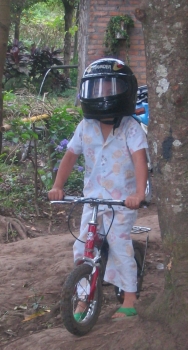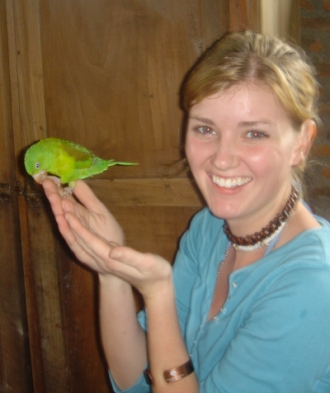|
|
Coffee harvest, traditional cooking lessons,
forest hike, a visit to hacienda workers in Barrio Nuevo, and farewell
dinner with a performance by local youth
Early in the morning,
prior to joining the rest of our group, Pam and I joined our host and
guide Alejandro for a walk around his family's farm, which includes
about three acres of coffee.
It was clear that these farmers -- like most others in La Corona --
thoroughly embrace agroforestry. This is an approach to agriculture
that looks messy compared to the neat rows of crops in a typical North
American farm field, but that is much better suited to tropical
conditions than are monocrops. The idea is to mimic the natural
vegetation -- tropical rain forest -- by raising crops and trees in
several layers. Large trees can provide shade (thereby conserving
water), protection from wind, and perhaps an occasional harvest of nuts
or even wood. Shorter trees can provide fruit, more shade and
protection of soil. Even smaller trees can provide coffee, or the
coffee can be left out in an area where the lowest layer is used for
beans, corn, or other row crops.
In the photo to the right, one of the taller trees serves a common
purpose for this area -- political poster. Red and black are the colors
of the Frente Sandinista para Liberacion Nacional (FSLN, or
Sandinistas). This is the party that spearheaded the ouster of Samoza
in the 1980s and fought against the U.S.-backed contras. Currently, FSLN is a
political party, whose leader -- Daniel Ortega -- is seeking a return
to the presidency.
|
 |
 |
 |
Cocoa grows well in the
region, though Nicaragua does not have the capacity to make chocolate
candy as it is known in the U.S. and Europe. Rather, cocoa is used to
flavor a popular regional drink that is based on corn. As Alejandro
showed us, the large cocoa seeds can also be enjoyed by sucking on them
like a candy.
|
|
 
Dona Elsa's household has a turkey with a blue head. This is so unusual
that when we mentioned it to one of the cooperative workers, she knew
immediately who we were staying with. The turkey is shown here drinking
grey water from the kitchen drain. At right is a boy who loved to ride
his bike around the house -- and around and around. When his dad
arrived on his motorcycle, the boy took advantage of the opportunity to
show off the helmet!
 
Every household seemed to have a bird! Dona Elso has small parakeet
that lives mostly in the windowsill and a talking parrot (not shown).
Kaitlyn is posing with a parakeet that became famous in our group. In
the household where Casey, Brandon, and Ben stayed, it is the custom to
spit on this bird for good luck (we
have video to
prove it), which Kaitlyn and Casey did after
lunch on this day. We later learned that this is not a common tradition
in the area, suggesting that the host family had perhaps migrated from
another part of the country.
 
Also at Dona Elsa's house, we observed coffee beans being sorted to
remove those with an odd shape or discoloration that would lower the
sale price. I assumed that the discarded beans were going to be used
for compost, but the cafetalero (coffee farmer) told me that these
discarded beans are processed for household use. I can tell report they
make fine coffee!
Below, Krystel is enjoying
one of the cocoa seeds Pam and I had gotten from Alejandro earlier. She
is sitting below a poster in the kitchen of Oscar's family, where she
stayed with Amy and Adrienne. Somebody had apparently given the family
this poster in the past, but without explaining what it is about. None
of the students staying with this family had much formal training in
Spanish, but they managed to explain the poster. I was very proud
throughout the trip of how hard our students worked to overcome the
language barrier.
At right, Alex is taking a photo of me taking a photo of him, as he and
Brooks pass by Oscar's house on their way into the community, with an
entourage from their host household. It turns out that the "village" of
La Corona is linear, with a single road joining a few dozen small farms
spread out over about two miles. It was not until the end of our stay
that the rest of us realized just how far Brooks, Alex, and their hosts
had to walk, just to be part of the group activities. They were all
good sports about it.

|

|
Finally, the moment I had been waiting for -- the opportunity to pick
coffee! When choosing between a January and a March date for the trip,
I chose January because we would have the chance to do the harvesting.
I thought this would be a good thing, primarily because we would get to
experience a little bit of the labor involved. What I did not realize
is that the harvest time is also the best time to see most of the other
interesting aspects of the bush-to-cup process.

|






